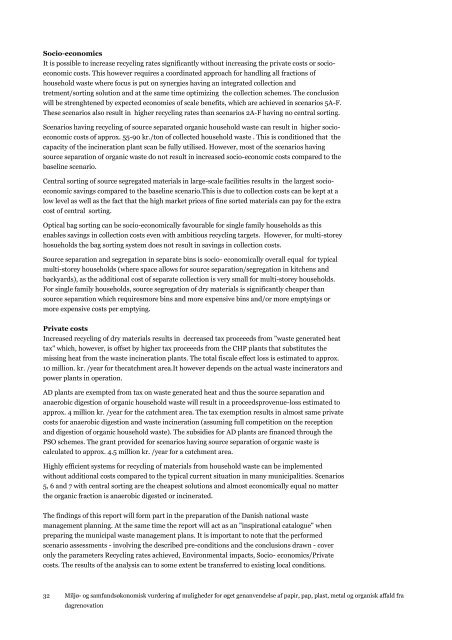Miljø- og samfundsøkonomisk vurdering af ... - Miljøstyrelsen
Miljø- og samfundsøkonomisk vurdering af ... - Miljøstyrelsen
Miljø- og samfundsøkonomisk vurdering af ... - Miljøstyrelsen
You also want an ePaper? Increase the reach of your titles
YUMPU automatically turns print PDFs into web optimized ePapers that Google loves.
Socio-economics<br />
It is possible to increase recycling rates significantly without increasing the private costs or socioeconomic<br />
costs. This however requires a coordinated approach for handling all fractions of<br />
household waste where focus is put on synergies having an integrated collection and<br />
tretment/sorting solution and at the same time optimizing the collection schemes. The conclusion<br />
will be strenghtened by expected economies of scale benefits, which are achieved in scenarios 5A-F.<br />
These scenarios also result in higher recycling rates than scenarios 2A-F having no central sorting.<br />
Scenarios having recycling of source separated organic household waste can result in higher socioeconomic<br />
costs of approx. 55-90 kr./ton of collected household waste . This is conditioned that the<br />
capacity of the incineration plant scan be fully utilised. However, most of the scenarios having<br />
source separation of organic waste do not result in increased socio-economic costs compared to the<br />
baseline scenario.<br />
Central sorting of source segregated materials in large-scale facilities results in the largest socioeconomic<br />
savings compared to the baseline scenario.This is due to collection costs can be kept at a<br />
low level as well as the fact that the high market prices of fine sorted materials can pay for the extra<br />
cost of central sorting.<br />
Optical bag sorting can be socio-economically favourable for single family households as this<br />
enables savings in collection costs even with ambitious recycling targets. However, for multi-storey<br />
hosueholds the bag sorting system does not result in savings in collection costs.<br />
Source separation and segregation in separate bins is socio- economically overall equal for typical<br />
multi-storey households (where space allows for source separation/segregation in kitchens and<br />
backyards), as the additional cost of separate collection is very small for multi-storey households.<br />
For single family households, source segregation of dry materials is significantly cheaper than<br />
source separation which requiresmore bins and more expensive bins and/or more emptyings or<br />
more expensive costs per emptying.<br />
Private costs<br />
Increased recycling of dry materials results in decreased tax proceeeds from "waste generated heat<br />
tax" which, however, is offset by higher tax proceeeds from the CHP plants that substitutes the<br />
missing heat from the waste incineration plants. The total fiscale effect loss is estimated to approx.<br />
10 million. kr. /year for thecatchment area.It however depends on the actual waste incinerators and<br />
power plants in operation.<br />
AD plants are exempted from tax on waste generated heat and thus the source separation and<br />
anaerobic digestion of organic household waste will result in a proceedsprovenue-loss estimated to<br />
approx. 4 million kr. /year for the catchment area. The tax exemption results in almost same private<br />
costs for anaerobic digestion and waste incineration (assuming full competition on the reception<br />
and digestion of organic household waste). The subsidies for AD plants are financed through the<br />
PSO schemes. The grant provided for scenarios having source separation of organic waste is<br />
calculated to approx. 4.5 million kr. /year for a catchment area.<br />
Highly efficient systems for recycling of materials from household waste can be implemented<br />
without additional costs compared to the typical current situation in many municipalities. Scenarios<br />
5, 6 and 7 with central sorting are the cheapest solutions and almost economically equal no matter<br />
the organic fraction is anaerobic digested or incinerated.<br />
The findings of this report will form part in the preparation of the Danish national waste<br />
management planning. At the same time the report will act as an "inspirational catal<strong>og</strong>ue" when<br />
preparing the municipal waste management plans. It is important to note that the performed<br />
scenario assessments - involving the described pre-conditions and the conclusions drawn - cover<br />
only the parameters Recycling rates achieved, Environmental impacts, Socio- economics/Private<br />
costs. The results of the analysis can to some extent be transferred to existing local conditions.<br />
32 Miljø- <strong>og</strong> samfundsøkonomisk <strong>vurdering</strong> <strong>af</strong> muligheder for øget genanvendelse <strong>af</strong> papir, pap, plast, metal <strong>og</strong> organisk <strong>af</strong>fald fra<br />
dagrenovation

















